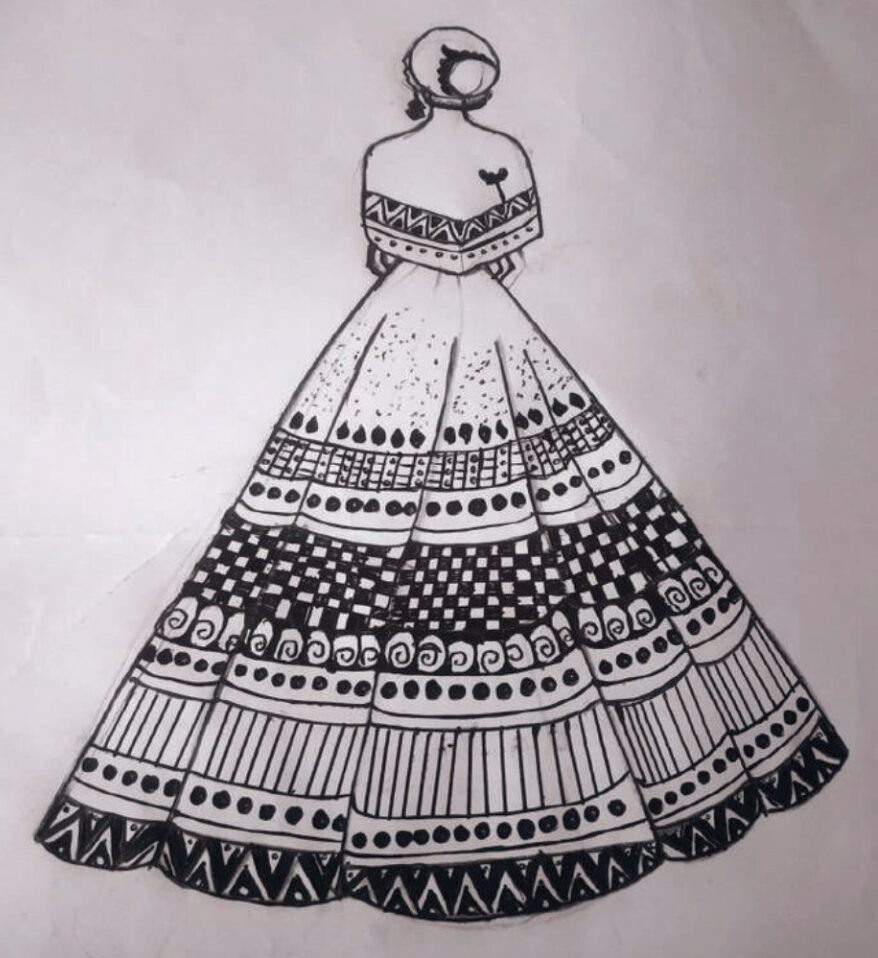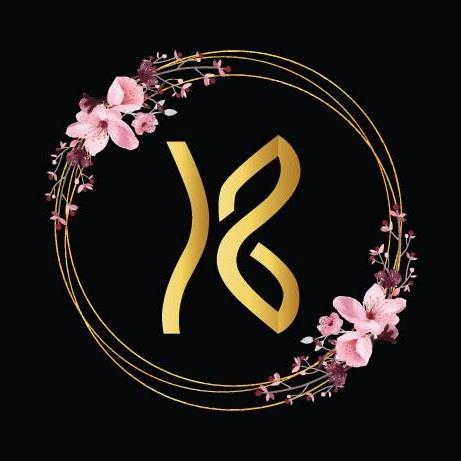Research Objectives
This study aims to understand fashion in the Pan-India focusing on Chikankari works.
Keywords
Fashion, Chikankari, Society, Pan-India
Bio
Kumkum Sheth is a Director and Fashion Designer. She founded Kiyana’s wardrobe due to her passion for the world of fashion and design. She specialises in a broad range of fashion due to her vast experience dominantly in India, Dubai and Singapore. She focusses on fusing the Indo western cultures together through her designs and professional expertise. Kumkum Sheth gained her BCom from Delhi university and was awarded her master’s degree MBA in marketing from NMIMS (Mumbai). Kumkum Sheth is captivated by the thought processes that go into designing an array of different garments and is inspired when clothes make cultural statements. Her flexibility in designing ethnic fashionwear led Kumkum Sheth to being awarded the Best Ethnic Designer of the Year 2021- 2022. She believes that the best designs are simple, yet amazingly adorned with smart crafted products and exquisite workmanship and skills from the city of Nawabs, Lucknow.
Abstract
Fashion is an important element of global societies and in many ways as it contributes to identity of individuals. The connections to culture and religion facilitates individuals to represent themselves and express their individuality. Fashion comprises of an array of styles and is continuously changing through history to contemporary life. All individuals make their own fashion choices, whether it consist of following societal trends, imitating global icons, public figures, or role models. This was evident through the coronavirus (covid-19) pandemic when the use of personal protection equipment (PPE) became mandatory. To some extent masks started to become a fashion accessory, as people started to match masks with their clothes to make it look ‘trendy’ or wearing masks comprising of designs. Clothes are usually worn in line with societal rules and regulations; however, fashion designing can be known to push societal norms. This study aims to understand fashion in the Pan-India focusing on Chikankari works. Through research and personal experiences results have revealed the following: Fashion and confidence, Individual beauty and comfort, Design and Empowerment. It is evident through the research conducted, that fashion is a means through which inner beaty can be highlighted suited to individual needs. Fashion has the ability to empower individuals to be themselves, be confident and glorifying their choices simultaneously bring cultures together.
Introduction
Fashion is an important element of global societies and in many ways as it contributes to the identity of individuals. It is an important industry that has investments of millions of pounds and also creates employment opportunities for individuals globally (Zam, Tavakoli, Ramezanian, & Rezasoltani, 2022). The fashion industry holds numerous festivals and exhibitions all around the word through which celebrities and global icons attend to endorse fashion products with the intention of attracting consumers. The world is continuously changing and evolving, with it are the tastes and expectation of consumers. It is important to understand fashion consumers, and this can be done through various methods of marketing and planning for the future. The connections to culture and religion facilitates individuals to represent themselves and express their individuality. Fashion comprises of an array of styles and is continuously changing through history to contemporary life. All individuals make their own fashion choices, whether it consist of following societal trends, imitating global icons, public figures, or role models. This was evident through the coronavirus (covid-19) pandemic when the use of personal protection equipment (PPE) became mandatory. To some extent masks started to become a fashion accessory, as people started to match masks with their clothes to make it look ‘trendy’ or wearing masks comprising of designs. Clothes are usually worn in line with societal rules and regulations; however, fashion designing can be known to push societal norms.
Due to the uniqueness of consumers, to meet their demands it is necessary to utilise methods of segmentation, targeting and positioning techniques so they can be put into groups that are rational. Through this technique each consumer is offered a fashion product that suits their unique needs. Hence fashion can be deemed as a social diffusion process within which novel products and styles are accepted by consumers (Lasi, Halabi, Jantan, & Azahari, 2021). Fashion is deemed to be a social phenomenon which has the power to affect different groups of individuals within societies. Simultaneously fashion is a personal choice that has the ability to affect people’s behaviours. It is evident that fashion motivations govern the decisions that consumers make (Esfandiari, Moradi, & Golmohammadi, 2021).
Chikankari
The Indian market has a rich culture and heritage that is reflected through fashion garments and clothes. However, it is also noticeable that it has been influenced by Western fashion. Although the term fashion comprises of a broad range of products it is dominantly referring to clothing and includes designers and producers of clothes many of which try to create a fusion between the east and west while keeping traditional focuses. A unique handmade embroidery that cannot be replicated is, chikankari. It comprises of embroidery techniques that are unique and possesses a range of various stitching methods. Chikankari is also renowned as Lucknowi Chikankari or Chikan Embroidery. For over two hundred years Lucknow has been the pinnacle of Chikan craftsmanship and involves more than 5000 families residing around the remote villages of Lucknow and are involved in the Chikankari embroidery industry contributing towards economic stability.
Objectives
This study aims to understand fashion in Pan-India focusing on Chikankari works. The study is conducted predominantly through sharing experiences from working within the Chikankari industry for several years.
Results and Discussion
Through research and personal experiences results have revealed the following: Fashion and confidence, Individual beauty and comfort, Design and Empowerment.
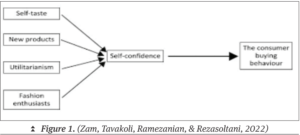
Fashion and confidence
Changes in fashion are usually accepted initially by leaders of the fashion industry in comparison to those that find it difficult to accept change. They do not fear trying new designs and styles, hence they become a source of inspiration, to other individuals within the same industry. Results have revealed that there is a positive relationship between fashion and self-confidence. Self-confidence is usually increased through individuals wearing new fashion garments. When individuals wear what they like and attach meaning to their garments, they feel increased self-confidence.
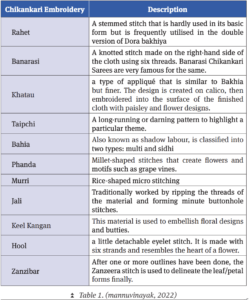
When individuals have heightened self-confidence it can contribute towards a positive effect on the behaviour of consumers. It is evident that individuals possess a variety of different attitudes when they adorn themselves with new fashion products. By generating an interest in fashion, consumers are more likely to accept news fashion products and it results in unified behaviours. Figure 1 illustrates the conceptual model of self-confidence and consumer buying behaviours. It reveals that self-taste, new products, utilitarianism, and fashion enthusiasts, all affect selfconfidence which directly impacts the consumer buying behaviours.
Individual beauty and comfort
Although beauty comes from within and it manifests outwards, individuals still want to look physically attractive. Each individual can adorn their beauty with their unique tastes and choice of various Chikankari embroidery styles. Table 1 highlights the different Chikankari embroidery styles and their descriptions:
Design and Empowerment
Step 1
The thought process behind making a garment is vital prior to implementing steps towards achieving the end goal. It is necessary for individuals to think about consumer needs. For example, the type of garment will it be a sari, an Indian dress, or an Indian outfit consisting of a top and bottom. Alternatively will it be an indo-western outfit that created a fusion of the eastern and western worlds. It is necessary to start the process through creating a vision of the end product and replicating it with a visual representation. This can be executed via sketching using pencil/ pens and paper. Alternatively, as we reside in a world of technological advancements appropriate software can be utilised to digitalise designs into a visual format using specialised software.
Step 2
Selecting the type of fabric that needs to be used, commonly Georget is utilised due to the weight enabling fine embroidery to be situated on the fabric ensuring good workmanship. Silk, organza, and khadi are also fabrics that are utilised.
Step 3
The printing process which can entail block printing, jaal printing, bail printing. The printing method is utilised in accordance with the garment being made. For example, if a sari is being made the likelihood is that the jaal printing method will be utilised while the boarder may be bail printing or block printing. Every method of printing consists of a special ink that is utilised to provide the desired good quality result.
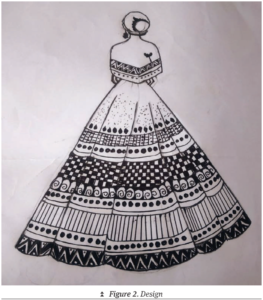
Embroidery can be considered as an intricate factor that requires care and due diligence. Normal basic chikankari is utilised in fabric for wearing in normal daily life, hence it can be considered as cheaper in price. In contrast, dokanka chikankari is much heavier than basic chikankari due to the fine intricate works that are embodied within the materials. The workmanship is intricate, yet the bold designs catch the eyes of observers of the garment. Thus, the finishing touch seems to be very fine in appearance. Ektaka chikankari is one of the rarest forms of chikankari and has a premium value due to the time it takes to complete the garment. From experience it can take approximately six months to complete this type of workmanship. Due to the complexity of the work involved, it is very difficult for individuals to distinguish if the work is carried out by a machine or it is handmade reaching stages of near perfection through the skills of fine craftspeople. Mukesh work is another form of embroidery which is carried out through very thin wires utilising cotton thread that can only be completed through using the hands.
Step 4
Washing the garment after embroidery is necessary and a process is followed to ensure this occurs without damaging the fine craftsmanship that has taken a length of time. The material needs to be completely dried then the material is dyed. Depending on the style of the garment, the material is dyed accordingly, for example Ombre dying consisting of a colour going from dark to light, or light to dark dependent on the style of the garment.
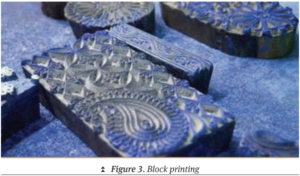
Step 5
Embellishment has become more popular over the last five to seven years. It is necessary to design the garments in accordance with the needs and tastes of consumers, therefore many consumers have a preference to embellish the garments. Embellishment is carried out using the following materials sequences, kartana, pearls, kundan which is pure gold or even zardozi consisting of gold and silver threads provide a heavier look.
Step 6
When the material is ready it is necessary for the material to be made into the design that is being created. For example, if it is going to be an Indian outfit consisting of a top and trousers, then it would be necessary to decide on if the top is long or short, A-line, or straight cut. Then decisions must be made regarding the designs pertaining to the selected style.
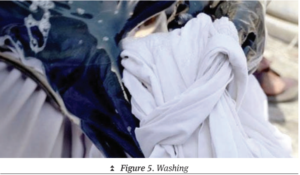
Step 7
After the designs have been finalised and the styles made, then stitching the outfit is the next step. This consists of ensuring the correct measurements of an individual is sort and fitted to the body shape and size. Any issues that arise are rectified at this stage and models are called to wear the outfits so that they can then be adorned, and photographs taken.
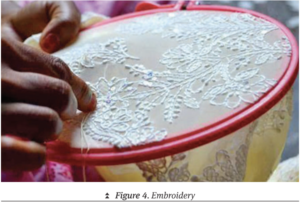
The process taken to achieve the result for the consumer takes a lot of hard work and dedication from all those involved. However, when the consumer is adorned with the finished garment the beauty and workmanship add to the charisma of the individual and has the ability to empower the consumer. Automatically their insecurities are replaced with confidence and positivity as they know that they looking how they imagined.
Conclusion
It is evident through the research conducted, that fashion is a means through which inner beaty can be highlighted suited to individual needs. Fashion has the ability to empower individuals to be themselves, be confident and glorifying their choices simultaneously bring cultures together.
There are numerous factors that can impinge upon the self-confidence of consumers who wish to purchase fashionable garments. This can reflect upon consumer behaviour, therefore during the initial search stages of making the government, thorough searches and information should be acquired to create a positive impact upon consumer behaviour. It is evident that branding is popular with consumers and manufacturers. It is also important for marketing purposes and influences on consumer behaviour and selfconfidence. The unique and diverse styles of Chikankari, the intricacies and exquisite craftsmanship allow an array of different styles and designs to be implemented suiting every consumer’s fashion needs in the eastern and western worlds.
References
Esfandiari, N., Moradi, M., & Golmohammadi, A. M. (2021). A fuzzy expertsystem to select a supply chain strategy: Lean, agile or leagile. Journal of Quality Engineering and Production Optimization, 201–218.
Lasi, M. S., Halabi, K. N., Jantan, A. H., & Aza-hari, M. H. (2021). Marketing technologies and its effect towards online purchasingbehaviour of fashion consumers in malaysia. Review of InternationalGeographical Education Online, 908–916.
Mannuvinayak, V. (2022, 09 11). Chikankari: A lucknawi Tradition. Retrieved from Khinkhwab: https:// khinkhwab.com/blogs/news/chikankari-a-lucknawi-tradition
Zam, M., Tavakoli, M., Ramezanian, H., & Rezasoltani, A. (2022). The Relationship between Consuming Fashion and Self-Confidence on the Buying Behaviour in the Clothing Market as a Mediator. Researchgate.

